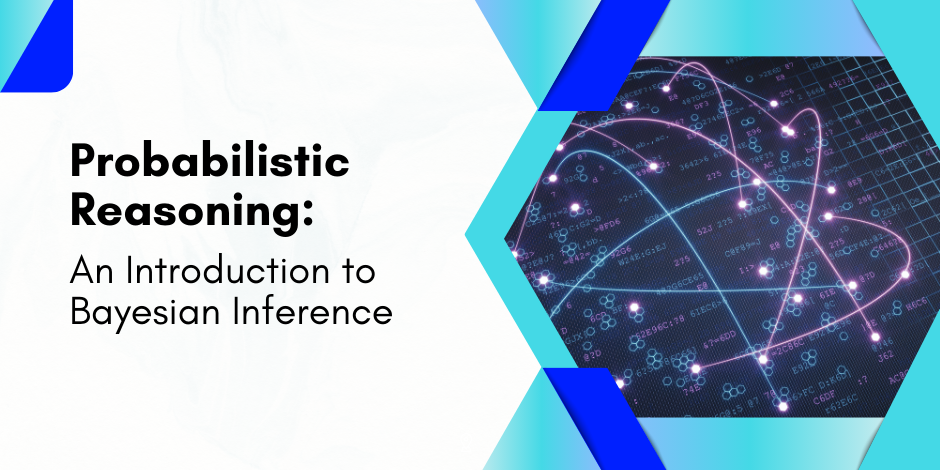Bayesian Inference: An Introduction to Probabilistic Reasoning

Stay Informed With Our Weekly Newsletter
Receive crucial updates on the ever-evolving landscape of technology and innovation.
Bayesian inference is a powerful tool that allows us to make informed decisions and draw conclusions based on probabilistic reasoning.
By understanding its fundamentals, we can unlock its potential and leverage it in various statistical modelling scenarios.
This article aims to provide a comprehensive overview of Bayesian inference, its principles, and its applications in statistical modelling.
So, let’s dive in!
The fundamentals

Bayesian inference has a rich history and development.
It traces its roots back to the 18th century, with the pioneering work of Thomas Bayes and Pierre-Simon Laplace.
Over the years, the field has evolved, and advancements in computing power have made it more accessible and widely used.
At its core, it relies on the principles of conditional probability and Bayes’ theorem.
– Conditional probability allows us to calculate the probability of an event given that another event has occurred.
– Bayes’ theorem provides us with a framework to update our beliefs in light of new evidence.
By combining prior knowledge and observed data, Bayesian inference enables us to obtain posterior probabilities, which represent our updated beliefs.
One of the key strengths is its ability to incorporate prior knowledge into the analysis.
This prior knowledge, often based on expert opinions or historical data, can be crucial in situations where data is limited or noisy.
By incorporating this prior information, Bayesian inference allows for a more nuanced and informed analysis, leading to more robust conclusions.
Furthermore, Bayesian inference is not limited to simple statistical models but can be applied to complex and high-dimensional problems.
With the advent of computational methods such as Markov chain Monte Carlo (MCMC) and variational inference, Bayesian analysis can now be performed on a wide range of problems, from image recognition to financial forecasting.
The Bayesian approach to probability
Conditional probability plays a crucial role in Bayesian inference.
It allows us to quantify the likelihood of an event occurring based on the occurrence of another event.
The Bayesian approach to probability considers probability as a measure of belief or uncertainty, rather than frequency or long-term proportion.
Understanding conditional probability
In the Bayesian framework, conditional probability is calculated using Bayes’ theorem.
It provides a systematic way of updating our initial beliefs (prior probabilities) based on observed or new evidence.
Bayes’ theorem can be expressed mathematically as:
P(A|B) = (P(B|A) * P(A)) / P(B)
Here, P(A|B) represents the posterior probability of event A given event B.
P(B|A) is the likelihood of observing event B given event A.
P(A) and P(B) are the prior probabilities of events A and B, respectively.
The role of prior and posterior probabilities
Prior probabilities represent our initial beliefs or knowledge about the probabilities of different events.
These probabilities are based on subjective judgments, expert opinions, or previous data analysis.
After observing some data or evidence, we can update our beliefs and obtain posterior probabilities.
The posterior probabilities reflect our updated beliefs and provide a more accurate representation of the true probabilities.
The Bayesian inference process

The process of Bayesian inference involves several steps.
These steps guide us through the analysis and ensure we make sound decisions based on our data and prior knowledge.
The steps involved in Bayesian inference
- Define the research question or problem: Clearly articulate the problem you aim to solve using Bayesian inference.
- Specify the prior probabilities: Determine the initial beliefs or probabilities based on available information.
- Collect and analyse data: Gather relevant data and analyse it using appropriate statistical methods.
- Update the prior probabilities: Apply Bayes’ theorem to combine the prior probabilities with the observed data and obtain posterior probabilities.
- Interpret the results: Interpret the posterior probabilities in the context of the research question and draw conclusions.
The importance of hypothesis testing in Bayesian inference
Hypothesis testing plays a crucial role in Bayesian inference.
It allows us to evaluate the evidence in support of different hypotheses and make decisions based on the strength of the evidence.
In Bayesian hypothesis testing, we calculate the Bayes factor, which measures the relative likelihood of observing the data under different hypotheses.
It provides a quantitative measure of the evidence in favour of one hypothesis over another.
Bayesian inference in statistical modelling
Bayesian inference finds extensive applications in statistical modelling.
It offers a flexible and robust approach to estimate model parameters, make predictions, and evaluate the uncertainty associated with these estimates.
The use of Bayesian inference in regression analysis
In regression analysis, Bayesian inference allows us to estimate the regression coefficients and make predictions with uncertainty intervals.
By incorporating prior knowledge about the coefficients, we can achieve more accurate and robust regression models.
Bayesian regression can handle complex models with a large number of predictors, and it provides a natural way to deal with outliers and missing data.
Additionally, it allows us to incorporate hierarchical structures to model dependencies among observations.
Bayesian networks and decision theory
Bayesian networks are graphical models representing the probabilistic relationships among a set of variables.
They provide a powerful framework to perform probabilistic reasoning and decision-making in the presence of uncertainty.
By using Bayesian networks, we can model complex systems and make informed decisions based on the available evidence.
These models are especially useful in fields such as healthcare, finance, and engineering, where uncertainty plays a significant role.
The advantages and limitations of Bayesian inference

Bayesian inference offers several advantages over traditional statistical methods. Let’s explore some of its strengths and potential drawbacks.
The strengths of Bayesian inference
- Bayesian inference provides a coherent and principled framework for incorporating prior knowledge into the analysis.
- It allows for flexible model specification, making it suitable for complex problems.
- Bayesian inference provides a natural way to handle missing data and outliers.
- It offers a full distributional representation of the parameters, allowing for more comprehensive uncertainty quantification.
The potential drawbacks of Bayesian inference
- Bayesian analysis can be computationally demanding, especially for large datasets or complex models.
- Subjective prior specification can potentially introduce bias in the results.
- Interpretation of Bayesian models may require a deeper understanding of probability theory and statistical concepts.
- Obtaining informative prior distributions can be challenging, especially in the absence of reliable prior knowledge.
Conclusion
Bayesian inference provides a powerful tool for understanding probabilistic reasoning.
By applying the principles of conditional probability and Bayes’ theorem, we can update our beliefs and draw informed conclusions based on the available evidence.
Bayesian inference has extensive applications in statistical modelling.
It offers a flexible and robust approach to parameter estimation, prediction, and decision-making.
While it has its strengths and limitations, understanding the fundamentals of Bayesian inference opens up a world of possibilities for data analysis and decision support.
Learn more about probabilistic reasoning by exploring the Institute of Data’s comprehensive Data Science & AI program.
Alternatively, you’re welcome to schedule a complimentary career consultation with one of our team members to discuss the program in further detail.





